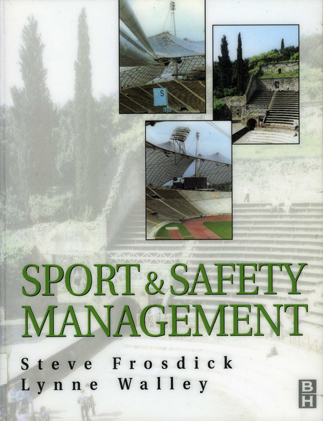Author: Steve Frosdick and Lynne Walley
ISBN No: 075064351X
Review date: 18/04/2024
No of pages: 314
Publisher: Butterworth-Heinemann
Publisher URL:
www.bh.com
Year of publication: 13/04/1997
Brief:
Mark Rowe, the editor of Professional Security magazine, continues his series looking at books or topics of the past with a security management angle. This time, it’s sports stadiums.
We can dimly begin to see that 1997 – the year that Sport and Safety Management, by Steve Frosdick and Lynne Walley was published – was a watershed, as momentous as 1476 when Caxton began printing in this country, or the Industrial Revolution. Around 1997, we each had our first encounters with email, and the internet. Every field of life – retail, the media, politics, crime and crime prevention – has since been ‘disrupted’. Everything is arguable, but I’d argue that sports ground operations have been relatively little affected. True, no more rolling up at a turnstile and paying cash – one less risk, no need for cash in transit – and more surveillance technology, networked. Yet the basics are the same as in Roman times – a crowd turns up, gets worked up, leaves again. As another book, From Ancient Rome to Rock N Roll, more from the stewarding angle, by the pioneer Mick Upton (who died in 2017), pointed out. As Frosdick and Whalley actually had a dozen contributors and 20 chapters, it’s more impossible than usual to digest it. I’ll try. If private security is a small world, it has many even smaller worlds within it, such as the ‘Circuit’ for close protection. Event security and crowd stewarding is one small world, and you can fragment it even further, into football ground safety, which I am told is a particularly competitive area for contract stewarding. While people in the field (pardon the pun) do a professional job, neutrally, so often they are enthusiastic about the game they are safeguarding, or a particular club.
Thus Steve Frosdick begins by recalling his first football match at Griffin Park (the west London home of Brentford FC) in 1967. And like many of us of a certain age, he can recall the Bradford fire (1985) and the Hillsborough disaster (1989). It was personal, an affront to decency, even, whereas to new generations of stewards and managers it’s history. A chapter that Frosdick co-authored with John Sidney, then the secretary of the Football Safety Officers Association (FSOA), recalled how football match days in the 1970s and 80s ‘often resembled military operations’ in a ‘repressive policing style’. As they said, Hillsborough was ‘the catalyst for major change’. It needed money – from TV – besides the political will, which had been lacking despite plenty of similar, smaller-scale accidents, let alone near-misses. Running through the book is the theme of risk management, including lower-profile police and usually steward-first policing of fans. Some things never change. Every season fans lose control – as some did at West Ham recently, and some at Liverpool stoned the visiting Manchester City bus.
Hooligans (or rather new generations of them) are still around; see a fine 2012 book by an academic, Geoff Pearson: Cans, Cops and Carnivals. Something absent from Frosdick’s 1997 book, because unheard of, is present in the draft, sixth edition of the ‘Green Guide’, the Sports Grounds Safety Authority (SGSA) guide to safety: terrorism. The attack on the Stade de France as part of the November 2015 terror attacks in Paris has, so far, been a watershed. Routinely security at the stadium perimeter now includes body searches, as if at a prison. Sport, despite its self-image as a uniter of people, sadly is a terror target like any other.










